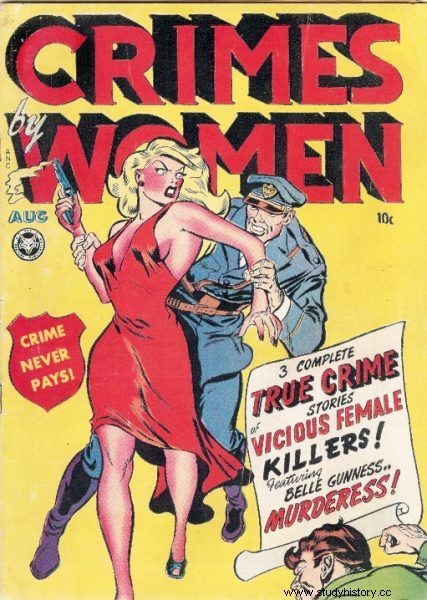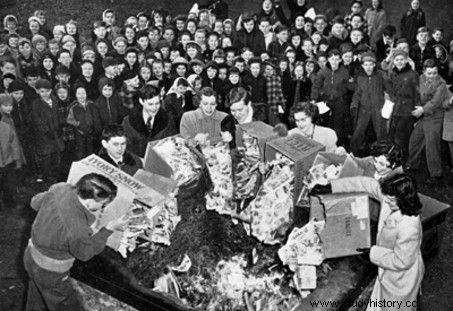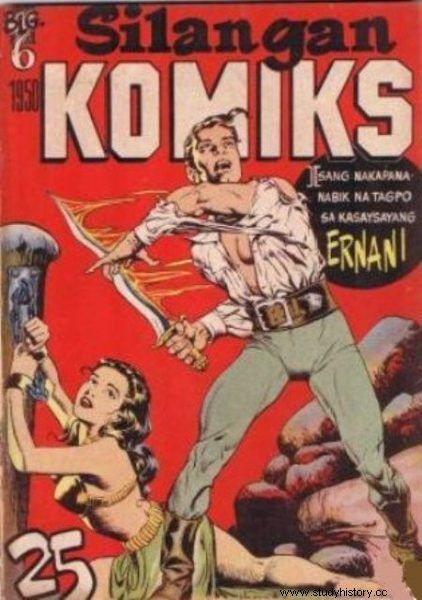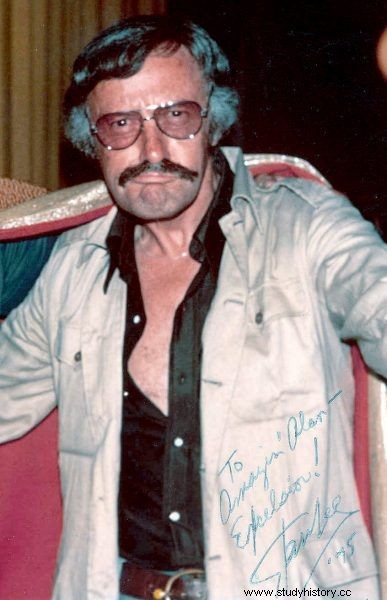"Evil so powerful that it poses a serious threat to the social and moral order in the country" - for some comic book publishing houses. The greatest heroes, Captain America or Superman, were powerless in the face of such allegations.
But the comic-book hunt goes back to before Captain America and World War II. In the 1930s, Catholic organizations, for example, considered them an enemy - as the National Organization for Decent Literature (NODL) was founded in 1938. The bishops said comics were "printed obscenities" and publications that "undermine morality and, as a result, destroy religion and lead to the overturning of the social order." NODL was so overwhelmed with its mission that it even attempted to make a calculation - 15 million immoral magazines were published that reached 60 million readers a month, and Bishop John F. Noll compared the content of the comics to the infiltration of American society by communist ideology . NODL even published its own newspaper "Priest", in which it published a subjective list of immoral comic book titles every month.
Predatory women and cheap propaganda
In 1940, an article appeared in The Chicago Daily News titled "A National Disgrace". Its author - Sterling North - noted that the comics contain "material that no self-respecting newspaper would accept," as well as:
On almost every page I came across heroic Superman-style feats, predatory women in skimpy clothing, fire-spitting guns, acts of justice by masked types, and cheap political propaganda.
Many American newspapers have reprinted this text. Some of the publishing houses, under public pressure, took decisive steps, including DC Comics formed a special editorial committee in 1941 to review comic book content .

Crimes by Women
Indecent literature
Fact, during the Second World War it was recognized that the Nazis are the bigger enemy than the comic book characters However, after defeating them, the fight against the pre-war plague was resumed. It is worth noting, however, that before comics became the enemy, NODL organizations fought, for example, with the cinema - they included their efforts led to the writing of the "Hays Code" in the 1930s, which indicated what content should not be included in film scenes. However, when the dust settled after World War II, the campaign for comics was resumed, and 1948 turned out to be a breakthrough in this fight. On March 2, 1948, a debate took place at ABC Radio with the title: "What's wrong with comics?" . At that time, the literary critic John Mason Brown called them, among others "marijuana in a child's room", "curse of children" or "a threat to the future" . In the same year, an article appeared in Time magazine suggesting that juvenile criminals were copying crimes they read about in comics. Additionally, such publications were to be full of communist ideology and sex.
"Seduction of the innocent"
This topic was quickly picked up by other American newspapers, and adults felt a pale fear, which is also actually read by their children. On the wave of popularity of the comic book problem, psychiatrist Fredric Wertham even organized a scientific symposium, during which participants concluded that comics glorify crime, violence and sex . "Abnormal sexual motives and criminal themes ... deceptive tricks, fraud and cruelty!" Rumbled Wertham, who in 1954 even published a book called "The Seduction of the Innocent." The effect of such action was the public smoking of comic books . Stacks burned in the centers of cities and towns:in squares, parking lots and school playgrounds. NODL triumphed.

Burning comics
Hitler is a piece of cake!
Interestingly, some comic book writers reacted in their own way to the accusations by Wertham. For example - Stan Lee published his own comic - "Crazy Maniac", the protagonist of which is Stan Lee himself, and its antagonist - a hero modeled on Werthman. After an argument between the gentlemen, it turns out that his opponent is ... a fugitive from the insane asylum. Lee himself referred to his activities as a psychiatrist:" For me, Wehrtham was no less than an ordinary fanatic . Human naivety never ceases to amaze me. ”
The national crusade against comics was not indifferent to the government, which in 1953 established the Senate Subcommittee on Juvenile Crime. The hearings and deliberations were to become a hit on TV (as was the case with the organized crime commission). Among others, in Denver, Boston and Philadelphia, and depending on the location, she dealt with another aspect of the demoralization of minors. In New York, the main topic was comics, and the main witness was Wertham himself, for whom the deliberations became a great opportunity to promote his own book. During the trial, he announced, “Hitler is a piece of cake in the comic book industry. Publishers reach the youngest. They teach four-year-olds to hate racial hatred before they even learn to read ” .
Ax in one hand, head in the other
Publishers, such as Wiliam Gaines from the EC publishing house, were also responsible to the committee. During his hearing, one of the senators, Estes Kefauver, pulled out - like a rabbit from a hat - the cover of number 22 of the Crime Suspenstories, there was a man holding a bloody ax in one hand and the severed head of a woman in the other, blood leaking from her mouth. Gaines could not protect himself and the whole comic book world. The next day, the loss of Kefauver to Gaines made headlines in US newspapers - including The New York Times, Time, and Newsweek. The hearing turned out to be the nail in the coffin of the comic book industry. Gaines had to drop the horror series, which is just one example of a comic book crash. If Goodman's comics were selling 15 million copies a month in 1955, by 1956 that number had dropped to 4.6 million.
Stan Lee talked about this period:
Parents forbade their children to read anything that had to do with life-long adventures, dynamic action, or tension-laden conflicts. " Violent murders have disappeared, and readers most often reached for science fiction, humorous stories with funny animals or westerns (as long as there was not too much violence in them!). "Millie the Model" and "Nellie the Nurse" were very popular.

Comics were considered the hotbed of evil
Approved!
In an attempt to save itself, the comics industry decided to set up its own committee - or rather an organization. The American Comic Book Association in 1954 published a list of its own rules known as the "Comic Book Code." They forced publishers to present comics to a group of reviewers. It was they who were to decide whether the subject matter was suitable for shop shelves, and they approached this task with clear overzealousness - the code was broken, among others, vampire themes or placing the word "horror" on the cover . After the content was approved by the committee, the comic received a stamp "approved", which the publisher could proudly put on the cover. However, such rules had their consequences, the most serious of which was the huge decline in the number of comics published. After a nationwide crusade, EC released its last comic. Such actions of the industry caused the Senate committee to look a bit more favorably on this industry - and in the report published in 1955, "Comics and juvenile delinquency", it indicated that the creation of the Code was a step in the right direction. The whole scandal already bored the American public opinion - when in April 1955 Wertham issued another publication defamatory of comics, it did not arouse such widespread attention.
Learning Tool
Although the comic book industry emerged from this struggle, scarred and weakened, it is worth emphasizing that it learned lessons for the following years. The creators put, among others, to promote comics as a learning tool - special lectures in schools were organized by, for example, DC Comics. Stan Lee also eagerly emphasized the educational value of comics. When, in 1970, the Department of Health, Education, and Human Services issued him an official letter asking him if he could publish a special anti-drug comic , Lee prepared an issue in which Spider-Man saved an intoxicated man. Later issues also featured Peter Parker's drug-addicted roommate, Harry Osborn. The introduction of the blind Daredevil character or the black hero - Black Panther (Marvel, who was responsible for these characters, wanted to emphasize that their publishing house raises important social issues) also contributed to the improvement of the comic book image.

Stan Lee 1975
Today nobody remembers about NODL or about Wertham. However, comic book releases enjoy unflagging popularity.
Bibliography:
- Batchelor Bob, Stan Lee, Man-Marvel, SQN Publishing House, Krakow 2018
- Howe Sean, The Amazing History of Marvel Comics, ed. Sine Qua Non, Krakow 2013
- Szyłak Jerzy, Comics, publ. Znak, Krakow 2000;
- Tucker Reed, The Beat. Marvel vs DC Superhero War. ed. Agora, Warsaw 2018
